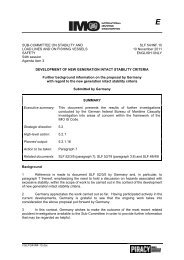Examination of the intact stability and the seakeeping behaviour
Examination of the intact stability and the seakeeping behaviour
Examination of the intact stability and the seakeeping behaviour
Create successful ePaper yourself
Turn your PDF publications into a flip-book with our unique Google optimized e-Paper software.
1.2 Following objectives for <strong>the</strong> diploma <strong>the</strong>sis<br />
ˆ The maximum rolling angle was about 30 ◦ .<br />
ˆ The maximum transversal accelerations on <strong>the</strong> bridge exceeded 1.0 g.<br />
ˆ One crew member was heavily injured.<br />
ˆ No damages to <strong>the</strong> vessel's hull occurred.<br />
1.2 Following objectives for <strong>the</strong> diploma <strong>the</strong>sis<br />
Due to <strong>the</strong> many similarities between <strong>the</strong> above mentioned three accidents, <strong>the</strong> question arises,<br />
whe<strong>the</strong>r o<strong>the</strong>r conventional container vessels also would encounter such high rolling angles <strong>and</strong><br />
accelerations on <strong>the</strong> bridge under <strong>the</strong> accident conditions named above.<br />
According to <strong>the</strong> actual <strong>intact</strong> <strong>stability</strong> code IMO A.749(18)[4], an approved trim <strong>and</strong> <strong>stability</strong><br />
booklet for each ship has to contain some st<strong>and</strong>ard loading conditions. Of those, <strong>the</strong> ballast<br />
arrival loading condition matches <strong>the</strong> loading condition <strong>of</strong> <strong>the</strong> ships in accident best. In this<br />
loading condition <strong>the</strong> ship operates without cargo, with 10 % bunker <strong>and</strong> stores as well as enough<br />
ballast water for sucient immersion <strong>of</strong> <strong>the</strong> hull. The propeller has to be immersed for adequate<br />
propulsion. Additionally <strong>the</strong> fore ship has to be immersed suciently to reduce slamming forces<br />
on <strong>the</strong> forward bottom shell. This results in a small KG <strong>and</strong> respectively a high GM.<br />
Fur<strong>the</strong>rmore lled ballast water tanks in <strong>the</strong> fore or aft part <strong>of</strong> <strong>the</strong> ship cause high, longitudinal<br />
bending moments to <strong>the</strong> ship's hull. The ship has to be ballasted, so <strong>the</strong> maximum allowed<br />
bending moment is not exceeded.<br />
Container ships in <strong>the</strong> ballast arrival loading condition operate always with a relatively high<br />
negative trim. Negative means, <strong>the</strong> ship's draught at <strong>the</strong> aft perpendicular is higher. The ballast<br />
arrival loading condition is m<strong>and</strong>atorily indicated to be a seagoing condition.<br />
Therefore <strong>the</strong> scope <strong>of</strong> this <strong>the</strong>sis is to examine, if container vessels in ballast<br />
arrival loading condition have an increased risk <strong>of</strong> accident in heavy seas due to <strong>the</strong><br />
design <strong>of</strong> this specic ship type.<br />
For this reason a larger number <strong>of</strong> container vessels <strong>of</strong> various size is analysed in <strong>the</strong> ballast<br />
arrival loading condition . The goal is to determine <strong>the</strong> <strong>seakeeping</strong> behavior for each vessel when<br />
it is encountering <strong>the</strong> three aforementioned accident situations. So <strong>the</strong> maximum rolling angle<br />
<strong>and</strong> <strong>the</strong> maximum transversal acceleration on <strong>the</strong> bridge are calculated, to estimate <strong>the</strong> risk<br />
<strong>of</strong> accident. All needed calculations are performed with <strong>the</strong> ship design s<strong>of</strong>tware E4, which is<br />
available at Hamburg University <strong>of</strong> Technology (TUHH). A detailed description <strong>of</strong> <strong>the</strong><br />
utilised methods can be found in chapter 2. In addition approaches to reduce <strong>the</strong> risk <strong>of</strong> accident<br />
shall be provided, examined <strong>and</strong> evaluated.<br />
3

















